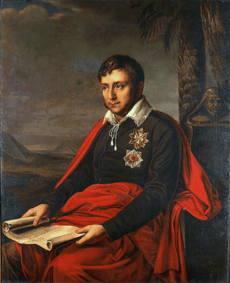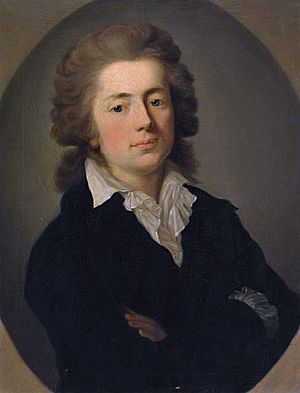Jan Potocki facts for kids
Quick facts for kids
Jan Potocki
|
|
|---|---|

Jan Potocki by Alexander Varnek
|
|
| Born | 8 March 1761 Pików, Podolia, Polish–Lithuanian Commonwealth
|
| Died | 23 December 1815 (aged 54) Uladivka, Vinnytsia, Russian Empire
|
| Nationality | Polish |
| Occupation |
|
| Era | Enlightenment |
| Known for | The Manuscript Found in Saragossa (1805) |
| Spouse(s) |
Julia Lubomirska
(m. 1783; died 1794)Konstancja Potocka
(m. 1799) |
| Children | five |
| Parents |
|
Count Jan Potocki (born March 8, 1761 – died December 23, 1815) was a famous Polish nobleman, explorer, and writer during the Age of Enlightenment. He was known for his exciting life and travels. Potocki was also an ethnologist, meaning he studied different cultures and peoples, and a linguist, someone who studies languages.
He is most famous for his adventure novel, The Manuscript Found in Saragossa. This book is a picaresque story, which means it follows a clever hero through many exciting and sometimes tricky situations.
Jan Potocki came from a very rich Polish family. He spent much of his childhood and got his education in Switzerland. He often visited important social gatherings in Paris and traveled all over Europe. He even fought as a soldier for the Austrian Empire and later became a military engineer in the Polish army.
During his many trips, he wrote down what he saw and learned about different customs, wars, and new ideas. This made him one of the first people to write travel literature. He was also very interested in ancient cultures, old traditions, and secret societies. At the same time, he was a member of the Polish parliament, taking part in important meetings before Poland changed greatly. Towards the end of his life, Jan Potocki faced health challenges and sadness.
Contents
Jan Potocki's Life and Adventures
Jan Potocki was born into the powerful Potocki family, who owned huge areas of land in Poland. He went to school in Geneva and Lausanne, Switzerland. He served in the Polish Army as a captain and even spent some time on a ship with the Knights of Malta. His amazing life took him across Europe, Asia, and North Africa. He learned about different cultures and helped start the study of ethnology. He was one of the first to study the early Slavic peoples by looking at their language and history.
In 1790, Jan Potocki became the first person in Poland to fly in a hot air balloon. He went up over Warsaw with a balloon pilot named Jean-Pierre Blanchard. This exciting event made him very popular with the public.
After spending time in France, he returned to Poland and became a well-known writer and publisher. He started newspapers and wrote pamphlets, which are small booklets, to suggest new ideas and changes for Poland. In 1788, he opened a publishing house called Drukarnia Wolna (Free Press) in Warsaw. He also opened the city's first free reading room, where people could come and read books.
Potocki's wealth allowed him to travel widely. He visited many countries, including Italy, Spain, Russia, Turkey, Egypt, and even Mongolia. He was one of the first travel writers of his time, writing exciting stories about his journeys. During these travels, he also studied history, languages, and different cultures in great detail.
Jan Potocki was married twice and had five children. In 1812, feeling unwell and disappointed, he moved to his estate in Uładówka (now Uladivka) in Ukraine. He was suffering from what was then called "melancholia," which today we might call depression. During these last few years, he finished writing his most famous novel.
The Manuscript Found in Saragossa: A Story of Mystery and Adventure

Jan Potocki's most famous book, The Manuscript Found in Saragossa (Manuscrit trouvé à Saragosse), was originally written in French. It is a frame tale, which means it's a story that contains many other stories within it. Because of its complex and layered structure, the novel is often compared to famous works like the Decameron and the Arabian Nights.
The book's title is explained at the beginning. A French officer finds an interesting Spanish manuscript during the attack on Zaragoza in 1809, during the Napoleonic Wars. The officer is later captured, but a Spanish officer realizes how important the manuscript is. While the French officer is a prisoner, the Spaniard translates the manuscript into French for him.
The manuscript was written by a young officer named Alphonse van Worden. In 1739, he is on his way to Madrid to join the Spanish Army but gets lost in the rugged Sierra Morena region of Spain. Over 66 days, he meets many different characters. These include Muslim princesses, Gypsies, outlaws, and kabbalists. They all tell him strange, funny, and amazing stories, which he writes down in his diary.
The stories in the book show Potocki's interest in secret societies, the supernatural, and oriental cultures. They also include his detailed observations of how people lived in 18th-century Europe, especially the upper class in Spain.
Many of the places described in the tales are real places that Potocki visited during his own travels. Other places are fictional, but based on real locations.
While there was some debate about who wrote the novel, it is now generally accepted that Jan Potocki wrote it. He started writing it in the 1790s and finished it in 1814, a year before he died. The main structure of the novel was likely planned out by 1805.
The novel was never fully published during Potocki's lifetime. Parts of it were printed in 1805 and 1813. It seems that when he died, Potocki had not yet decided on the final version of his book.
Potocki wrote the entire book in French. Some parts of the original writings were lost, but they survived because a complete French copy was translated into Polish in 1847 by Edmund Chojecki. This Polish translation helped keep the full story alive.
A very complete French version of the novel was published in 2006. This version was put together by experts who found Potocki's original French writings in libraries across Europe. They found two main versions of the novel: one from 1804 that was unfinished, and a full version from 1810 that was quite different. The first version is lighter and more questioning, while the second is darker and more serious. Because of these differences, both versions have been published as separate books.
The first English translation of the novel came out in 1995. The book became even more famous thanks to a stylish black-and-white film adaptation made in 1965. It was directed by Wojciech Has and starred Zbigniew Cybulski as Alphonse van Worden.
Jan Potocki's Travel Memoirs
Jan Potocki wrote several books about his travels and studies. Here are some of them:
- Histoire Primitive des Peuples de la Russie avec une Exposition complete de Toutes les Nations, locales, nationales et traditionelles, necessaires a l'intelligence du quatrieme livre d'Herodote (published in 1802)
- Voyage dans les steppes d'Astrakhan et du Caucase (published in 1829)
- Voyage en Turquie et en Egypte (1788; translated into Polish in 1789)
- Voyage dans l'Empire de Maroc (1792)
More recent editions of his travel writings include:
- Voyages en Turquie et en Egypte, en Hollande, au Maroc (1980; new edition, 1991)
- Voyage au Caucase et en Chine (1980)
Honours and Awards
Jan Potocki received several important awards for his service and achievements:
- Order of the White Eagle
- Order of Saint Stanislaus, 1st Class
- Order of St. Vladimir, 1st Class
See also
 In Spanish: Jan Potocki para niños
In Spanish: Jan Potocki para niños
- Back-translation of The Saragossa Manuscript
- List of Egyptologists
- List of Poles
- Polish literature


